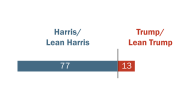I. Overview
The boom-and-bust cycle in the U.S. housing market over the past decade and a half has generated greater gains and larger losses for minority groups than it has for whites, according to an analysis of housing, economic and demographic data by the Pew Hispanic Center, a project of the Pew Research Center.1 From 1995 through the middle of this decade, homeownership rates rose more rapidly among all minorities than among whites. But since the start of the housing bust in 2005, rates have fallen more steeply for two of the nation’s largest minority groups—blacks and native-born Latinos—than for the rest of the population.
Overall, the ups and downs in the housing market since 1995 have reduced the homeownership gap between whites and all racial and ethnic minority groups. However, a substantial gap persists. As of 2008, 74.9% of whites owned homes, compared with 59.1% of Asians, 48.9% of Hispanics and 47.5% of blacks.
At the same time, blacks and Latinos remain far more likely than whites to borrow in the subprime market where loans are usually higher priced.2 In 2007, 27.6% of home purchase loans to Hispanics and 33.5% to blacks were higher-priced loans, compared with just 10.5% of home purchase loans to whites that year. For black homeowners who had a higher-priced mortgage, the typical annual percentage rate (APR) was about 3 percentage points greater than the rate on a typical 30-year, fixed-rate conventional mortgage; for Latinos who had a higher-priced mortgage, the typical rate was about 2.5 percentage points higher than that of the conventional mortgage.
Moreover, in 2007, blacks and Hispanics borrowed higher amounts than did whites with similar incomes, exposing themselves to greater debt relative to their incomes. On both counts—the likelihood of higher-priced borrowing and higher debt relative to income—the gap between minorities and whites is greater among high-income households than among low-income households.
This study analyzes three major interrelated aspects of the U.S. housing market: trends in homeownership from 1995 through the middle of 2008 among different racial, ethnic and nativity groups;3 higher-priced lending to Hispanics and blacks in 2006 and 2007; and differences in foreclosure rates across the nation’s 3,141 counties.
One surprise to emerge from this analysis is that the recent decline in the homeownership rate has hit native-born heads of households harder than immigrant householders. Immigrant householders are less likely than native-born householders to be homeowners (52.9% versus 70.0% in 2008) but their losses in recent years have been smaller than those of the native born.
The explanation for the relatively modest impact of the recent housing market turmoil on immigrants appears to lie in the changing characteristics of the foreign born. Among other things, the typical immigrant in 2008 had spent more years in the U.S. and was more likely to be a U.S. citizen than was the typical immigrant in 1995. Those factors, strongly associated with higher rates of homeownership, appear to have mitigated recent troubles in the housing market among immigrants.
The analysis reveals that blacks and native-born Hispanics are among those who experienced the sharpest reversal in homeownership in recent years. Overall, the homeownership rate in the U.S. dropped from 69.0% in 2004 to 67.8% in 2008, a loss of 1.2 percentage points. Over the same period, the homeownership rate for black households decreased 1.9 percentage points, from 49.4% to 47.5%, reversing four years of gains. The homeownership rate for native-born Latinos peaked a year later in 2005. But since then it has fallen from 56.2% to 53.6%, a loss of 2.6 percentage points in just three years.4
Immigrant households did not experience similar losses in homeownership. For all immigrants, the homeownership rate declined modestly, from a high of 53.3% in 2006 to 52.9% in 2008. The rate for foreign-born Latinos has yet to diminish. It reached a peak of 44.7% in 2007 and was unchanged in 2008.
This report also focuses on differences in 2008 foreclosure rates across the nation’s 3,141 counties and the role of demography in explaining those differences.5 In 2008, the national foreclosure rate was 1.8%, triple the rate in 2006. But the foreclosure rate—or the percentage of housing units with at least one foreclosure filing—varies widely across counties. The analysis finds that counties with higher shares of immigrant residents had elevated rates of foreclosure. It is estimated that of two counties with similar economic and demographic characteristics, the one whose immigrant share of the population is 10 percentage points higher than the other has a foreclosure rate that is 0.6 percentage points higher.
But it cannot be inferred from this finding that immigration levels in and of themselves are the cause of elevated foreclosures. In recent years, the construction boom attracted immigrants in large numbers into new settlements in the U.S. (Kochhar, Suro and Tafoya, 2005; Frey, Berube, Singer and Wilson, 2009) Many of these areas, such as Nevada’s Clark County, which includes Las Vegas, are now experiencing sharp reversals in construction and a wave of foreclosures.6 Thus, the presence of immigrants in a county may simply signal the effects of a boom-and-bust cycle that has raised foreclosure rates for all residents in that county.
The state of the local economy is also an important determinant of foreclosures. A county’s unemployment rate that is 1 percentage point higher than in a typical county is associated with a foreclosure rate that is 0.1 percentage points higher. Home prices falling annually by about 2 percentage points more compared with a typical county are also estimated to raise foreclosure rates by 0.1 percentage points.7 Local housing costs, as reflected in high loan-to-income ratios, and a greater incidence of higher-priced lending to blacks and Hispanics are also linked to higher foreclosure rates.8
Data from a number of sources are used in this study. They include demographic and homeownership data from the Census Bureau’s American Community Survey (ACS) and Current Population Survey (CPS), foreclosure data from RealtyTrac®, loan data from the Home Mortgage Disclosure Act (HMDA), labor market data from the Bureau of Labor Statistics (BLS), and home prices from the Federal Housing Finance Agency (FHFA).
The major findings of the study are as follows:
Homeownership
Homeownership Rate: The percent of householders, or heads of households who report living in owner-occupied homes.
- Homeownership in the U.S. expanded rapidly from 1994 to 2004 but has declined since then. Some 69.0% of all households owned homes in 2004 compared with 64.0% in 1994. The homeownership rate fell each year after 2004 and stood at 67.8% in 2008.
- Homeownership among Hispanics increased more quickly and for a longer time than homeownership overall. The Latino homeownership rate peaked at 49.8% in 2006, compared with 42.1% in 1995. It was unchanged in 2007 and fell to 48.9% in 2008.
- Black householders raised their homeownership rate from 41.9% in 1995 to 49.4% in 2004. By 2008, the black homeownership rate had decreased to 47.5%.
- Immigrant householders are less likely to be homeowners than those who are native-born, but their losses in recent years were relatively modest. Homeownership among immigrant householders increased from 46.5% in 1995 to 53.3% in 2006 and then fell to 52.9% in 2008.
- Among native-born householders, the homeownership rate increased from 66.1% in 1995 to 71.5% in 2004, peaking two years earlier than for immigrants. The native-born homeownership rate in 2008 was 70.0%.
- Foreign-born Latinos have not experienced a reversal in homeownership. Their homeownership rate increased from 36.9% in 1995 to 44.7% in 2007 and was unchanged through the first half of 2008.
- Native-born Hispanics raised their homeownership rate sharply, from 47.2% in 1995 to 56.2% in 2005. But they also experienced a sharp turnabout, as their homeownership rate dropped to 53.6% in 2008.
Loans for Home Purchase
Higher-Priced Home Purchase Loans: Mortgage loans with annual percentage rates that exceed the rate on U.S. Treasury securities of comparable maturity by a specified threshold (3 percentage points for first-lien loans). Often used as a proxy for lending activity in the subprime market.
- There was a precipitous drop in the number of loan applications for home purchases from 2006 to 2007. Nationwide, the number of applications decreased 25.2%, and there was an accompanying drop of 25.0% in the number of loans originated. Some of this drop is due to a lack of reporting by lenders that ceased operation in 2007, but the vast majority reflects a real drop in market activity.
- Loan applications for home purchases by Hispanics fell 38.2% from 2006 to 2007. Applications from blacks decreased 34.4% during the same period, and the number of white applicants decreased 18.9%.
- Among Hispanics, loan applications from the highest income group decreased at a faster rate (41.0%) from 2006 to 2007 than did applications from the lowest income group (23.8%).
- The median amount borrowed by Hispanic home buyers in 2007 was $197,000, somewhat higher than for blacks ($168,000) and whites ($180,000). When compared with others with similar incomes, blacks also borrow more than whites.
- Loan-to-income ratios are higher for Hispanic and black households than for whites. The gap between minorities and whites is greater among high-income households.
- Some 14.2% of overall home purchase loans in 2007 were higher-priced loans. But 27.6% of loans issued to Hispanics and 33.5% of loans issued to blacks in 2007 were higher priced. Only 10.5% of loans to whites were higher priced.
- High-income Hispanics and blacks are about as likely as low-income Hispanics and blacks to receive a higher-priced loan. That is not the case for high-income whites who are half as likely as low-income whites to receive a higher-priced loan.
Foreclosures
Foreclosure Rate: Percentage of housing units with at least one foreclosure filing in the year.
- The national foreclosure rate tripled from 2006 to 2008, increasing from 0.6% to 1.8%.
- The foreclosure rate was 5% or more in 33 of the nation’s 3,141 counties. Of those 33 counties, California was home to 12 and Florida to 10. Virginia and Nevada accounted for three counties each.
- The highest foreclosure rate in the nation was 12.0% in Florida’s Lee County, which includes Fort Myers and Cape Coral.
- The typical county in the U.S. had a foreclosure rate of 0.6% in 2008. That is the simple average of foreclosure rates across 3,141 counties.9 The foreclosure rate was less than 0.6% in 2,164 counties.
- The vast majority of counties in several states that are either traditional immigration destinations or notable new areas of settlement have foreclosure rates that are higher than in the typical county—157 of 178. These counties are in California, Arizona, Nevada, Florida and New Jersey.
- Higher shares of immigrants in county populations are associated with higher foreclosure rates. But this does not mean that immigration in and of itself is the cause of elevated foreclosures.
- Higher foreclosure rates across counties are also associated with higher unemployment levels, home price depreciation or slower appreciation, home prices that are high relative to income levels and higher proportions of higher-price mortgage loans to Hispanic and black homeowners.
About this Report
This study analyzes three major interrelated aspects of the U.S. housing market: trends in homeownership from 1995 through the middle of 2008 among racial, ethnic and nativity groups; higher-priced lending to Hispanics and blacks in 2006 and 2007; and differences in foreclosure rates across the nation’s 3,141 counties.
A Note on Terminology
The terms “Latino” and “Hispanic” are used interchangeably in this report, as are the terms “foreign born” and “immigrant.” The terms “whites,” “blacks” and “Asians” are used to refer to their non-Hispanic components.
Foreign-born refers to an individual who is born outside of the United States, Puerto Rico or other U.S. territories and whose parents are not U.S. citizens.




